Discover 35 hidden attractions, cool sights, and unusual things to do in Canberra (Australia). Don't miss out on these must-see attractions: Australian War Memorial, Old Parliament House, and Parliament House. Also, be sure to include National Museum of Australia in your itinerary.
Below, you can find the list of the most amazing places you should visit in Canberra (Australian Capital Territory).
Table of Contents
Australian War Memorial
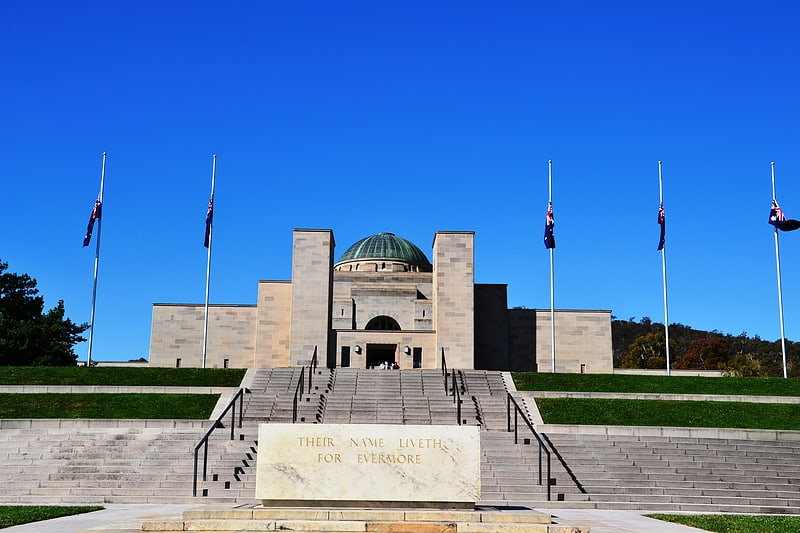
National site of military commemoration. The Australian War Memorial is Australia's national memorial to the members of its armed forces and supporting organisations who have died or participated in wars involving the Commonwealth of Australia and some conflicts involving personnel from the Australian colonies prior to Federation. Opened in 1941, the memorial includes an extensive national military museum.
The memorial is located in Australia's capital, Canberra, in the suburb of Campbell. The Australian War Memorial forms the north terminus of the city's ceremonial land axis, which stretches from Parliament House on Capital Hill along a line passing through the summit of the cone-shaped Mount Ainslie to the northeast. No continuous roadway links the two points, but there is a clear line of sight from the front balcony of Parliament House to the War Memorial, and from the front steps of the War Memorial back to Parliament House.
The Australian War Memorial consists of three parts: the Commemorative Area (shrine) including the Hall of Memory with the Tomb of the Unknown Australian Soldier, the Memorial's galleries (museum) and Research Centre (records). The Memorial also has an outdoor Sculpture Garden. The Memorial is currently open daily from 10am until 5pm, excluding Christmas Day.
Other monuments and memorials located on the adjacent Anzac Parade are maintained separately by the National Capital Authority (NCA) and do not form part of the Australian War Memorial.[1]
Address: Treloar Cres, 2612 Campbell (North Canberra)
Old Parliament House

Home of Museum of Australian Democracy. Old Parliament House, formerly known as the Provisional Parliament House, was the seat of the Parliament of Australia from 1927 to 1988. The building began operation on 9 May 1927 after Parliament's relocation from Melbourne to the new capital, Canberra. In 1988, the Commonwealth Parliament transferred to the new Parliament House on Capital Hill. It also serves as a venue for temporary exhibitions, lectures and concerts.
On 2 May 2008 it was made an Executive Agency of the Department of the Prime Minister and Cabinet. On 9 May 2009, the Executive Agency was renamed the Museum of Australian Democracy at Old Parliament House, reporting to the Special Minister of State.
Designed by John Smith Murdoch and a team of assistants from the Department of Works and Railways, the building was intended to be neither temporary nor permanent—only to be a "provisional" building that would serve the needs of Parliament for a maximum of 50 years. The design extended from the building itself to include its gardens, décor and furnishings. The building is in the Simplified or "Stripped" Classical Style, commonly used for Australian government buildings constructed in Canberra during the 1920s and 1930s. It does not include such classical architectural elements as columns, entablatures or pediments, but does have the orderliness and symmetry associated with neoclassical architecture.[2]
Address: Canberra, 18 King George Terrace, Parkes, Canberra, Australian Capital Territory
Parliament House
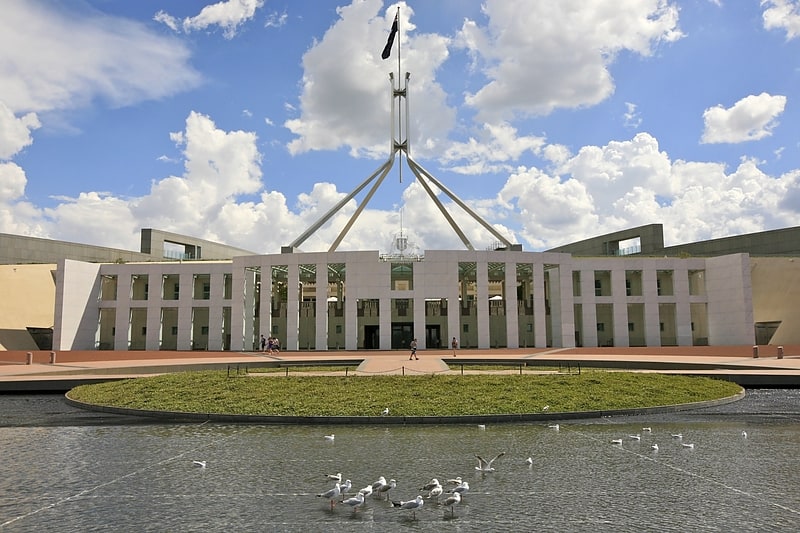
Expansive structure opened in 1988. Parliament House, also referred to as Capital Hill or simply Parliament, is the meeting place of the Parliament of Australia, and the seat of the legislative branch of the Australian Government. Located in Canberra, the Parliament building is situated on the southern apex of the Parliamentary Triangle atop Capital Hill, at the meeting point of Commonwealth, Adelaide, Canberra and Kings Avenue enclosed by the State Circle.
Parliament House was designed by Mitchell/Giurgola & Thorp Architects and built by a Concrete Constructions and John Holland joint venture. It was opened on 9 May 1988 by Elizabeth II, Queen of Australia. It cost more than A$1.1 billion (equivalent to about $4.3 billion in 2018) to build.
Federal Parliament meetings were held in Melbourne until 1927. Between 1927 and 1988, the Parliament of Australia met in the Provisional Parliament House, which is now known as "Old Parliament House". Construction of Australia's permanent Parliament House was delayed while its location was debated. Construction of the new building began in 1981. The principal design of the structure is based on the shape of two boomerangs and is topped by an 81-metre (266 ft) flagpole. The flag above Parliament House is one of the Biggest in Australia at a huge 12.8 metres by 6.4 metres.
Parliament House contains 4,700 rooms, and many areas are open to the public. The main foyer contains a marble staircase and leads to the Great Hall, which has a large tapestry on display. The House of Representatives chamber is decorated green, while the Senate chamber has a red colour scheme. Between the two chambers is the Members' Hall, which has a water feature and is not open to the public. The Ministerial Wing houses the Prime Minister's Office and other ministerial offices.[3]
Address: Parliament Dr, 2600 Canberra (South Canberra)
National Museum of Australia
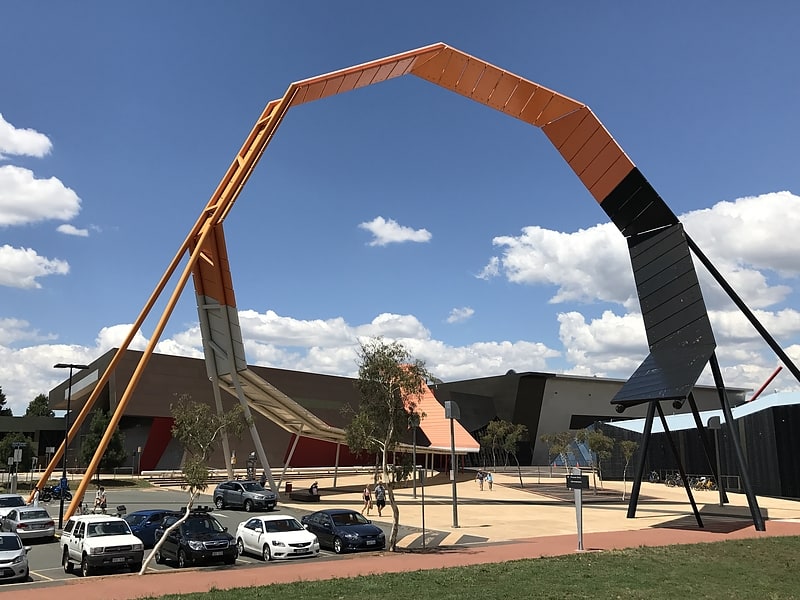
Exhibits spanning social history. The National Museum of Australia, in the national capital Canberra, preserves and interprets Australia's social history, exploring the key issues, people and events that have shaped the nation. It was formally established by the National Museum of Australia Act 1980.
The museum did not have a permanent home until 11 March 2001, when a purpose-built museum building was officially opened.
The museum profiles 50,000 years of Indigenous heritage, settlement since 1788 and key events including Federation and the Sydney 2000 Olympics. The museum holds the world's largest collection of Aboriginal bark paintings and stone tools, the heart of champion racehorse Phar Lap and the Holden prototype No. 1 car.
The museum also develops and travels exhibitions on subjects ranging from bushrangers to surf lifesaving. The National Museum of Australia Press publishes a wide range of books, catalogues and journals. The museum's Research Centre takes a cross-disciplinary approach to history, ensuring the museum is a lively forum for ideas and debate about Australia's past, present and future.
The museum's innovative use of new technologies has been central to its growing international reputation in outreach programming, particularly with regional communities. From 2003 to 2008, the museum hosted Talkback Classroom, a student political forum.
The museum is located on Acton Peninsula in the suburb of Acton, next to the Australian National University. The peninsula on Lake Burley Griffin was previously the home of the Royal Canberra Hospital, which was demolished in tragic circumstances on 13 July 1997.[4]
Address: Lawson Crescent, 2601 Canberra (North Canberra)
Lake Burley Griffin

Scenic man-made place for recreation. Lake Burley Griffin is an artificial lake in the centre of Canberra, the capital of Australia. It was completed in 1963 after the Molonglo River, which ran between the city centre and Parliamentary Triangle, was dammed. It is named after Walter Burley Griffin, the American architect who won the competition to design the city of Canberra.
Griffin designed the lake with many geometric motifs, so that the axes of his design lined up with natural geographical landmarks in the area. However, government authorities changed his original plans, and no substantial work was completed before he left Australia in 1920. Griffin's proposal was further delayed by the Great Depression and World War II, and it was not until the 1950s that planning resumed. After political disputes and consideration of other proposed variations, excavation work began in 1960 with the energetic backing of Australian Prime Minister Robert Menzies. After the completion of the bridges and dams, the dams were locked in September 1963. However, because of a drought, the lake's target water level was not reached until April 1964. The lake was formally inaugurated on 17 October 1964.
The lake is located in the approximate geographic centre of the city, and it is the centrepiece of the capital in accordance with Griffin's original designs. Numerous important institutions, such as the National Gallery, National Museum, National Library, Australian National University and the High Court were built on its shores, and Parliament House is a short distance away. Its surrounds, consisting mainly of parklands, are popular with recreational users, particularly in the warmer months. Though swimming in the lake is uncommon, it is used for a wide variety of other activities, such as rowing, fishing, and sailing.
The lake is an ornamental body with a length of 11 kilometres (6.8 mi) and a width, at its widest, of 1.2 kilometres (0.75 mi). It has an average depth of 4 metres (13 ft) and a maximum depth of about 18 metres (59 ft) near the Scrivener Dam. Its flow is regulated by the 33-metre-tall (108 ft) Scrivener Dam, designed to handle floods that occur once in 5,000 years. In times of drought, water levels can be maintained through the release of water from Googong Dam, located on an upstream tributary of the Molonglo River.[5]
Aboriginal Tent Embassy
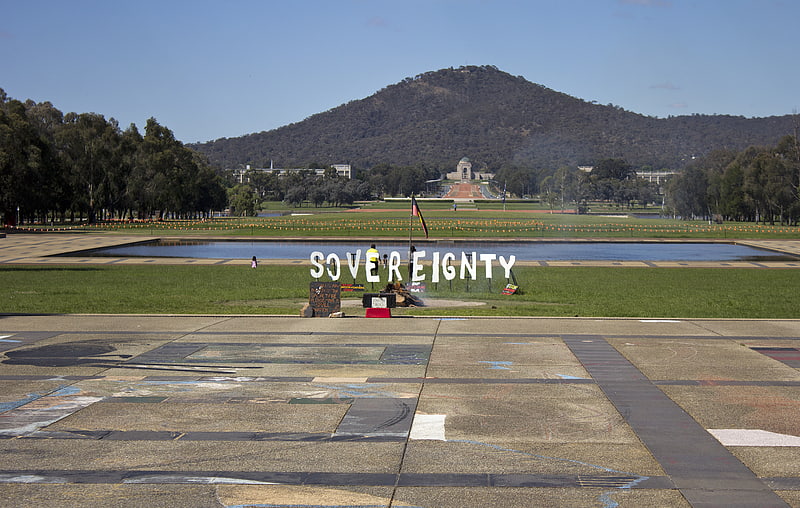
Park in Parkes, Australia. The Aboriginal Tent Embassy is a permanent protest occupation site as a focus for representing the political rights of Aboriginal Australians and Torres Strait Islander people. Established in 1972, and celebrating its 50th anniversary in 2022, it is the longest continuous protest for Indigenous land rights in the world.
First established in 1972 under a beach umbrella as a protest against the McMahon government's approach to Indigenous Australian land rights, the Aboriginal Tent Embassy is made up of signs and tents. Since 1992 it has been located on the lawn opposite Old Parliament House in Canberra, the Australian capital. It is not considered an official embassy by the Australian Government. The Embassy has been a site of protest and support for grassroots campaigns for the recognition of Indigenous land rights in Australia, Aboriginal deaths in custody, self-determination, and Indigenous sovereignty.[6]
Commonwealth Park
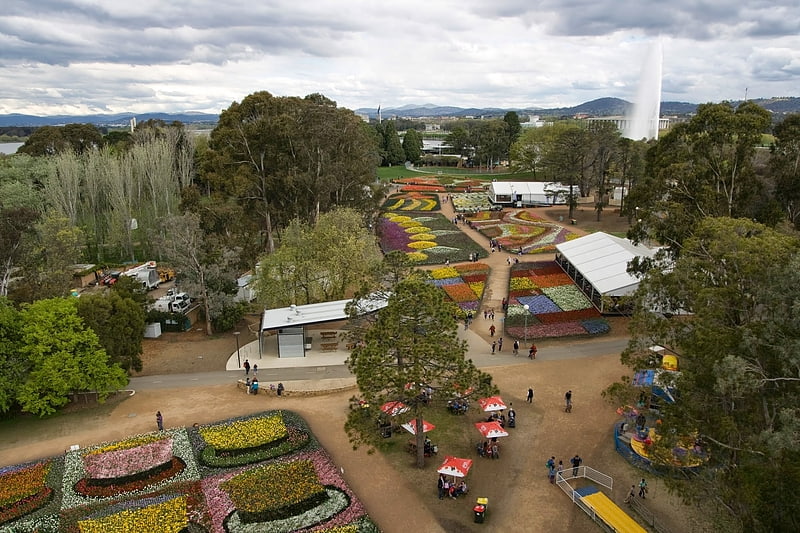
Park in Parkes, Australia. Commonwealth Park is in Canberra, Australia, adjacent to the north side of Lake Burley Griffin. Centrally located in the city, it is an important part of the urban landscape. The park has an area of 34.25 hectares, which includes a variety of natural and constructed spaces.
Various designers have been involved in the construction of the park including Charles Weston, Lindsay Pryor, Richard Clough and John Grey. The park in it current form was strongly influenced by a master plan created by British landscape designer, Dame Sylvia Crowe in 1964.
The park has many small ponds and water features, walking trails, bike paths, sculptures and memorials. Located within the park is the outdoor Stage 88, which often holds concerts. The park includes Regatta Point and has a view of the National Gallery, High Court, and National Library on the other side of the lake. Kings Park is located adjacent to Commonwealth Park, along the lake to the east.
Commonwealth Park is the home of many events hosted in Canberra. Among them is Floriade, an annual event that has been running since 1988.[7]
Address: Regatta Pl., 2600 Canberra (South Canberra)
Cockington Green Gardens
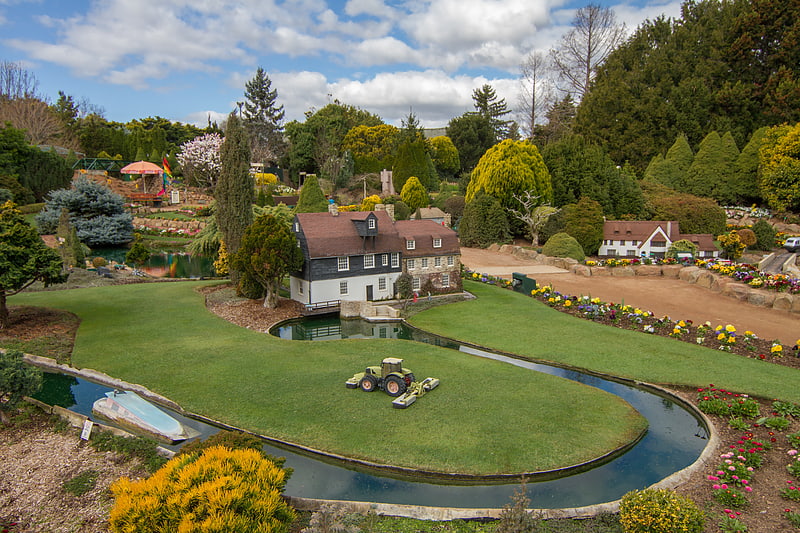
Amusement park in Nicholls, Australia. Cockington Green Gardens is a park of miniatures, situated in Nicholls, Australian Capital Territory. Doug and Brenda Sarah had the idea to create a miniature village in 1972, and Cockington Green was opened on 3 November 1979.
The business is family owned and operated, incorporating over four generations.[8]
Address: 11 Gold Creek Rd, 2913 Nicholls (Gungahlin)
Telstra Tower
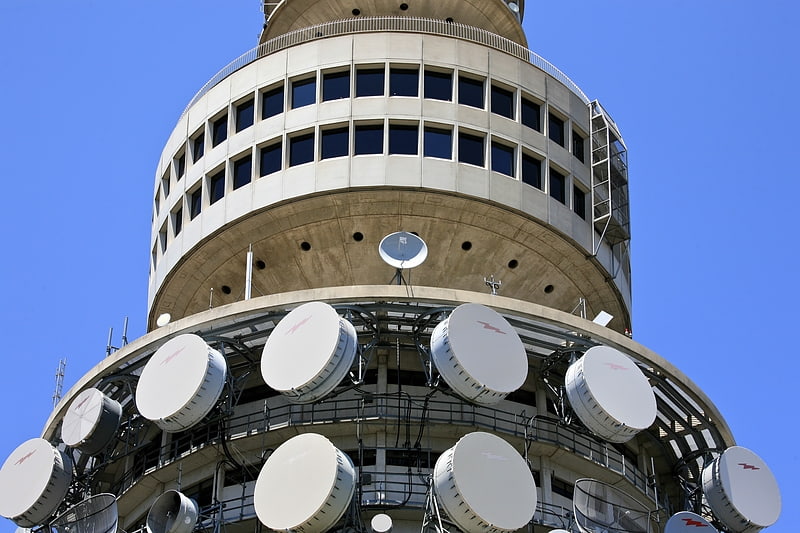
195m-tall telecommunications tower. Telstra Tower is a telecommunications tower and lookout that is situated above the summit of Black Mountain in Australia's capital city of Canberra. It is named after Australia's largest telecommunications company, Telstra Corporation, which owns and operates the tower. Rising 195.2 metres above the mountain summit, it is a landmark in Canberra and offers panoramic views of the city and its surrounding countryside from an indoor observation deck and two outdoor viewing platforms.[9]
Address: Black Mountain Drive, Canberra
Questacon
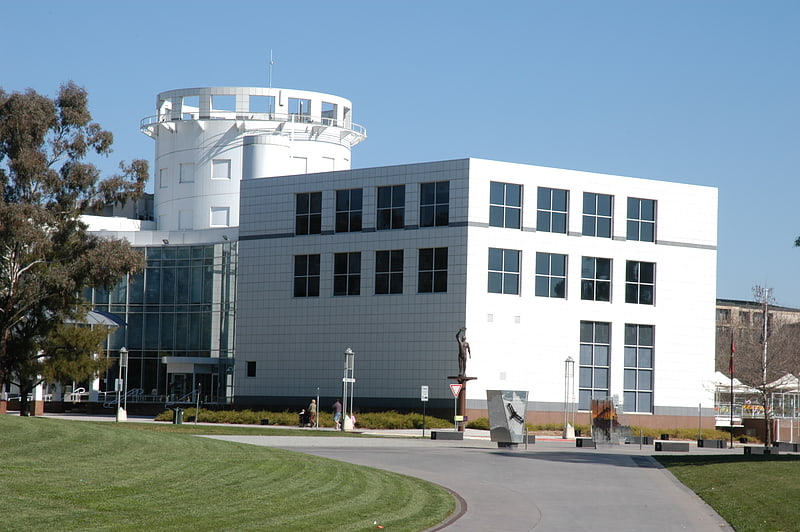
Interactive kids' science and tech museum. Questacon – the National Science and Technology Centre is an interactive science communication facility in Canberra, Australia. It is a museum with more than 200 interactive exhibits relating to science and technology. It has many science programs that are intended to inspire the children of Australia to love science.
Complimenting the main museum, Questacon Science Circus is an outreach program and is the most extensive science outreach program of its kind in the world. Each year, the Science Circus engages with more than 100,000 people, travels 25,000 kilometers, runs professional development courses for 600 teachers and visits about 30 remote aboriginal communities as well as hospitals, nursing homes and special schools.[10]
Address: King Edward Terrace, 2600 Canberra (South Canberra)
Australian National Botanic Gardens

Scenic botanical park with walking paths. The Australian National Botanic Gardens is a heritage-listed botanical garden located in Acton, Canberra, in the Australian Capital Territory, Australia. Established in 1949, the Gardens is administered by the Australian Government's Department of Agriculture, Water and the Environment. The botanic gardens was added to the Commonwealth Heritage List on 22 June 2004.
The botanic gardens is the largest living collection of native Australian flora. The mission of the ANBG is to "study and promote Australia's flora". The gardens maintains a wide variety of botanical resources for researchers and cultivates native plants threatened in the wild. The herbarium code for the Australian National Botanic Gardens is CANB.[11]
Address: Clunies Ross St, 2601 Canberra
Mount Stromlo Observatory
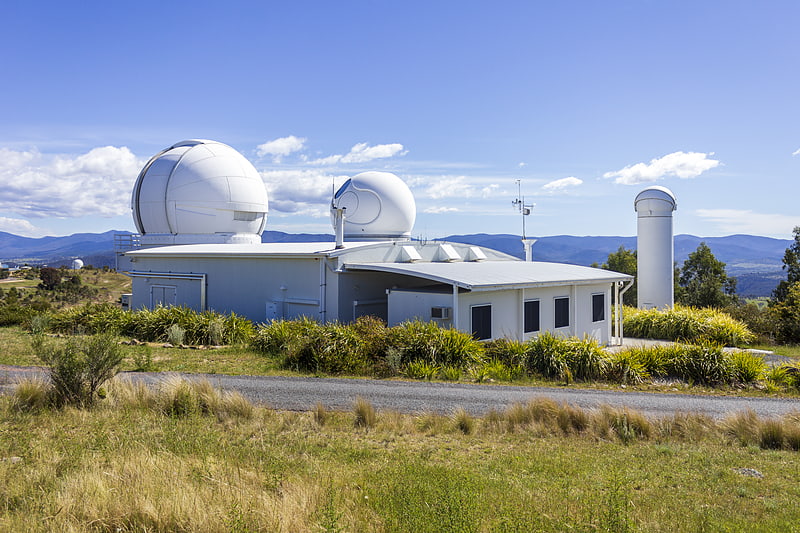
Astronomy and astrophysics research HQ. Mount Stromlo Observatory located just outside Canberra, Australia, is part of the Research School of Astronomy and Astrophysics at the Australian National University.[12]
City Hill

City park in Canberra, Australia. City Hill is a park located in Canberra, Australia on one of the points of the Parliamentary Triangle, a feature of Walter Burley Griffin's plan for the city. The park is surrounded by Vernon Circle, at the south end of Northbourne Avenue, but beyond Vernon Circle it is further surrounded by the concentric London Circuit, and the area between Vernon Circle and London Circuit can also be seen as part of the hill. City Hill is an integral part of the city centre design. To the south of the hill Northbourne Avenue becomes Commonwealth Avenue, and further along is Commonwealth Avenue bridge.
The hill was planted in 1921. The design, supervised by Charles Weston, Canberra's first Superintendent of Parks and Gardens, was to emphasise the vistas along the six avenues radiating from the hill and reinforce the focus that Griffin placed on the hill as forming part of the Parliamentary triangle. At the centre of the hill is a flagpole flying the ACT flag since 1989 when the territory became self-governing. Immediately surrounding the flagpole are double staggered rows of closely spaced Roman cypresses (Cupressus sempervirens Stricta). Radiating outwards are twelve oval shaped groups of Roman cypresses and six groups of Monterey pines (Pinus radiata) reinforcing the symmetrical nature of the design. In 2014 the Canberra Centenary Column was added to the park, to commemorate Canberra's centenary.
The park is centrally located and well-known, but it is rarely visited as it is away from shops and public areas and is difficult to access because it is surrounded by a major road. The prominent flagpole at the centre of Vernon Circle is not actually at the highest point of City Hill. The highest point of City Hill is to the south east, overlooking Lake Burley Griffin. Unusually for the centre of a large city and as a result of the relative isolation of City Hill, a small variety of mushrooms can be found growing under the pine trees.[13]
Commonwealth Avenue Bridge
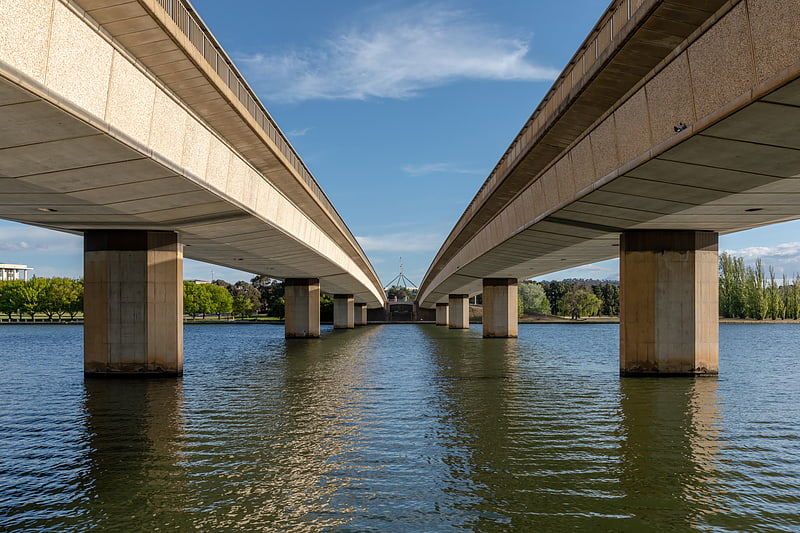
Bridge. The Commonwealth Avenue Bridge are two parallel pre-stressed concrete box girder road bridges that carry Commonwealth Avenue across Lake Burley Griffin, and connect Parkes and City in Canberra, in the Australian Capital Territory, Australia.[14]
National Gallery of Australia

Grand showcase of aboriginal and other art. The National Gallery of Australia, formerly the Australian National Gallery, is the national art museum of Australia as well as one of the largest art museums in Australia, holding more than 166,000 works of art. Located in Canberra in the Australian Capital Territory, it was established in 1967 by the Australian Government as a national public art museum. As of 2022 it is under the directorship of Nick Mitzevich.[15]
Address: Parkes Place, 2601 Canberra (South Canberra)
Captain James Cook Memorial
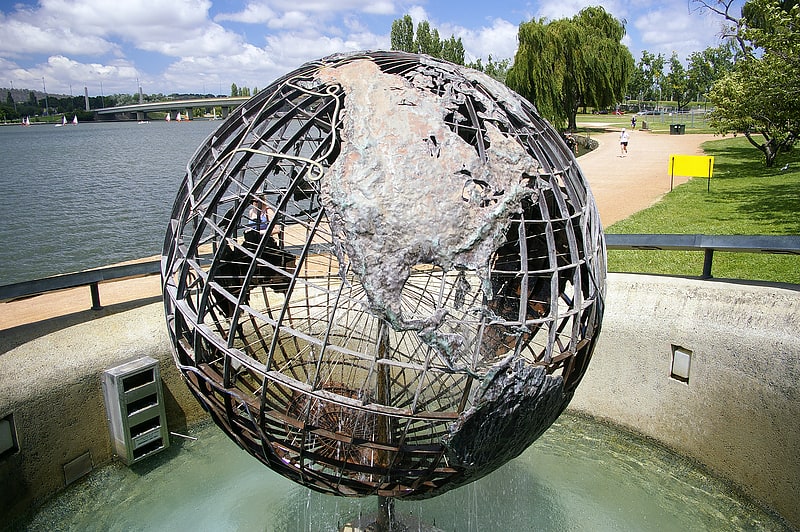
Historical place in Parkes, Australia. The Captain James Cook Memorial was built by the Commonwealth Government to commemorate the Bicentenary of Captain James Cook's first sighting of the east coast of Australia. The memorial includes a water jet located in the central basin and a skeleton globe sculpture at Regatta Point of Lake Burley Griffin in Canberra, showing the paths of Cook's expeditions. On 25 April 1970, Queen Elizabeth II officially inaugurated the memorial.
The water jet is driven by two 4-stage centrifugal pumps capable of pumping up to 250 litres per second against a head of 183 metres. The water velocity at the water nozzle is 260 km/h. While running both pumps simultaneously the main jet throws approximately six tons of water into the air at any instant, reaching a maximum height of 152 metres. Alternatively the jet can be run on a single pump reaching a lower height of 114 metres. During special occasions it can be illuminated, often with coloured lights. The design of the jet is based on the Jet d'Eau in Geneva, Switzerland as a result of high-level diplomatic negotiations.
The water jet operates daily from 11am to 2pm. In periods of high wind, the jet is automatically disabled as water landing on the nearby Commonwealth Avenue Bridge can be a hazard to traffic. The water jet must also be occasionally shut down when drought lowers the water level of the lake.[16]
Address: Barrine Dr., 2600 Canberra (South Canberra)
Calthorpes' House
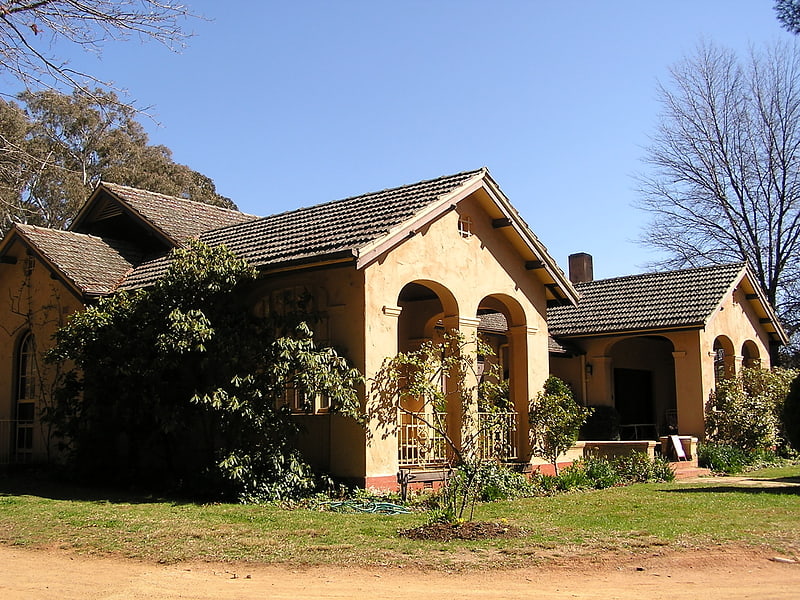
Calthorpes' House is a heritage-listed house located at 24 Mugga Way, Red Hill, Canberra, Australian Capital Territory.
It was built in 1927 for Harry and Dell Calthorpe. Harry Calthorpe was a partner in Calthorpe and Woodger, a successful Queanbeyan-based stock and station and real estate agency. The house was designed by Ken Oliphant of Oakley and Parkes, the architectural firm responsible for the residence of the Prime Minister of Australia, The Lodge. Sir Charles Rosenthal had initially been selected to design the house; however, his plans were not used.
Harry Calthorpe died at age 59 in 1950, and Dell Calthorpe remained in the house until her death in 1979. The house and its contents had remained largely unchanged for many years, and both the Calthorpe family and historians recognised its historical value and later, potential for a house museum. It was purchased by the Government of Australia in late 1984, and was opened as a museum in 1986. It continues to operate as a museum today.
Calthorpes' House is a snapshot of domestic life for a family of four in a late 1920s three-bedroom Canberra house, however it is not entirely representative, given the larger than average house and garden, and there have been some minor changes and additions over time. There is an air raid shelter behind the house which is still preserved, and was built in response to the risk of bombing of Canberra during the war.
It was added to the Australian Capital Territory Heritage Register on 27 September 1996 and to the former Register of the National Estate on 25 March 1986.[17]
Address: 24 Mugga Way, 2004 Canberra (South Canberra)
National Dinosaur Museum
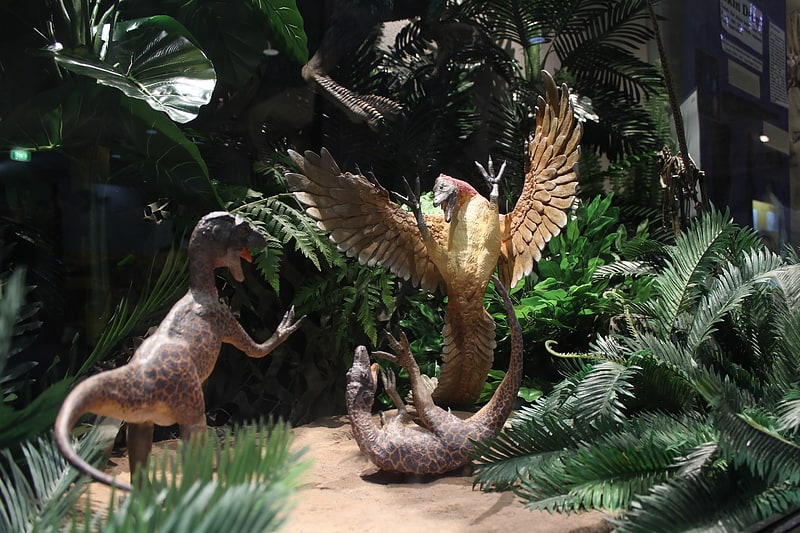
Skeletons, fossils and life-like models. The National Dinosaur Museum is Australia's largest permanent display of prehistoric specimens, located in Gold Creek Village near Canberra, Australian Capital Territory, Australia.
The museum's exhibition follows the evolution of life, with a particular focus on dinosaurs.
With an annual patronage of 100,000 visitors, the museum is one of the most popular attractions in the Australian Capital Territory. The gift shop stocks a range of natural history books, dinosaur replicas, toys, fossils, crystals, minerals and meteorites.
Established in 1993, the museum has been steadily improved and updated since its conception. It offers earth science dinosaur oriented displays that keep up with most recent discoveries in the geological sciences. in September 2011, Jeno Kapitany, Martin Rowe, Chris Michael and Kate Michael were been appointed including local and international scientist and geologist Tom Kapitany. Major upgrades have taken place in April and May 2012 with the addition of twelve animatronic dinosaurs as well as an extensive collection of life size models displayed both within and outside the museum.
The museum caters for guided tours for school groups of all ages by appointment, as well as hosting birthday parties, dance with dinosaurs events for young children, private parties, corporate functions and dinosaur sleep overs during school holiday periods. New displays of Australian dinosaurs, earth sciences including meteorites, fluorescent mineral displays were added over 2012 and 2013.
Opening hours are 10am to 5 pm seven days a week including public holidays, but are closed Christmas Day. After hours visits are available by appointment only.[18]
Address: Cnr Gold Creek Road and Barton Highway, 2913 Canberra (Gungahlin)
Manning Clark House
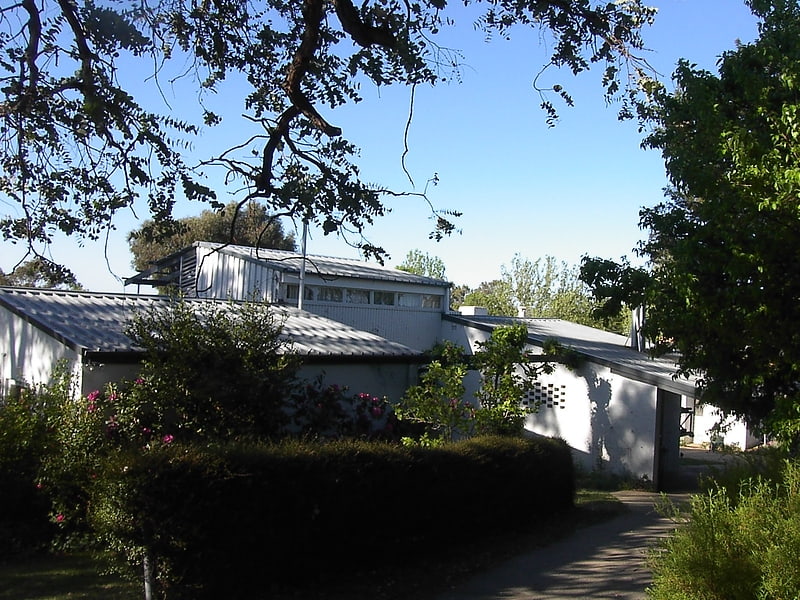
The Manning Clark House, designed by Australian architect, Robin Boyd in 1952, is a house located at 11 Tasmania Circle, Forrest, a suburb of Canberra in the Australian Capital Territory. The house was built for Professor Manning Clark, described as "Australia's most famous historian", and his wife, Dymphna Clark, a linguist and educator.
The house in now home to Manning Clark House Inc. (MCH), a community based institution that nurtures creative practice and research in Australian history, human rights, literature, music, visual art, and indigenous culture, as well as discussion and debate on issues of public importance and all areas of scholarly interest. The organisation supports the intellectual and creative community through a network of scholars and community garden. The program includes public lectures, open forums, seminars, conferences, art exhibitions, poetry readings, concerts, book launches, human rights education, and social gatherings in the former home of Manning and Dymphna Clark.
Following the 2000 death of Dymphna Clark, the house was transferred to community use.
A full calendar of events is available on the webpage.[19]
National Carillon
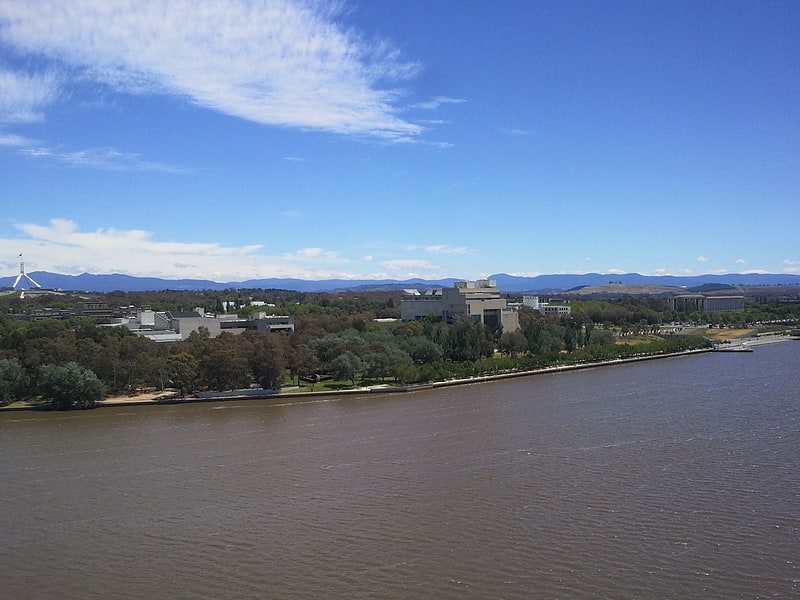
Lakefront bell tower that chimes often. The National Carillon is a large carillon situated on Aspen Island in Lake Burley Griffin, central Canberra, in the Australian Capital Territory, Australia. The carillon is managed and maintained by the National Capital Authority on behalf of the Commonwealth of Australia. It has 57 bells, ranging nearly 5 octaves from the 6,108 kg bass bell in F# to the 8 kg treble bell in D.[20]
Address: Kings Park, Canberra (South Canberra)
Kings Park
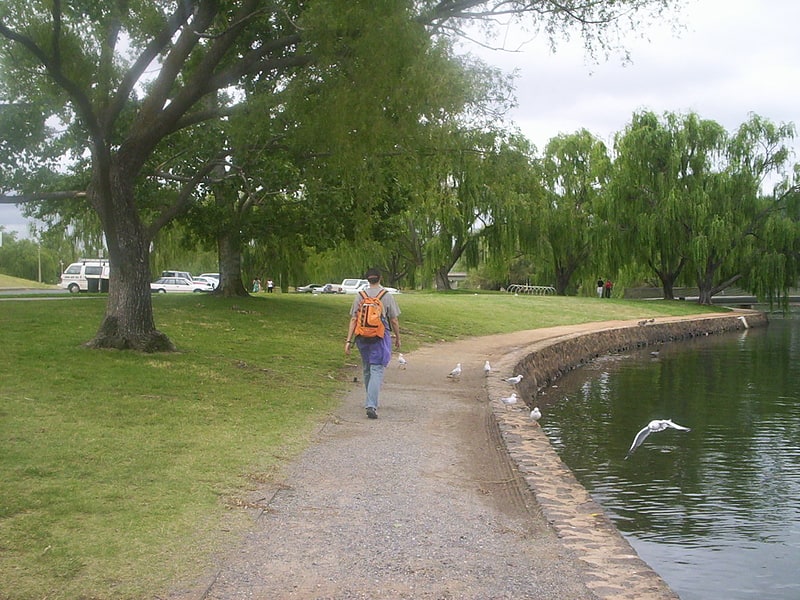
Park in Parkes, Australia. Kings Park is a park in Canberra, Australia on the shore of Lake Burley Griffin.
Kings Park is adjacent to Kings Avenue, on the north side of Lake Burley Griffin's Central Basin. The park has a number of community and heritage spaces located within it. Kings Park is located adjacent to Commonwealth Park, which lies to its west, with the two parks separated by a red gravel assembly area at the base of Anzac Parade. The area is federally owned, and cared for by the National Capital Authority.
Blundells Cottage is located within the Kings Park precinct, having been constructed before the parkland was developed.
Several spaces designed for community engagement and enjoyment exist within the Park. The National Carillon, which conducts regular free musical programs, is located on Aspen Island, just off the shore of Kings Park. Boundless, a children's play ground designed to allow easier access for people with disabilities, is located closely to the Police and Workers Memorials.[21]
Address: Wendouree Dr., 2600 Canberra (South Canberra)
National Portrait Gallery
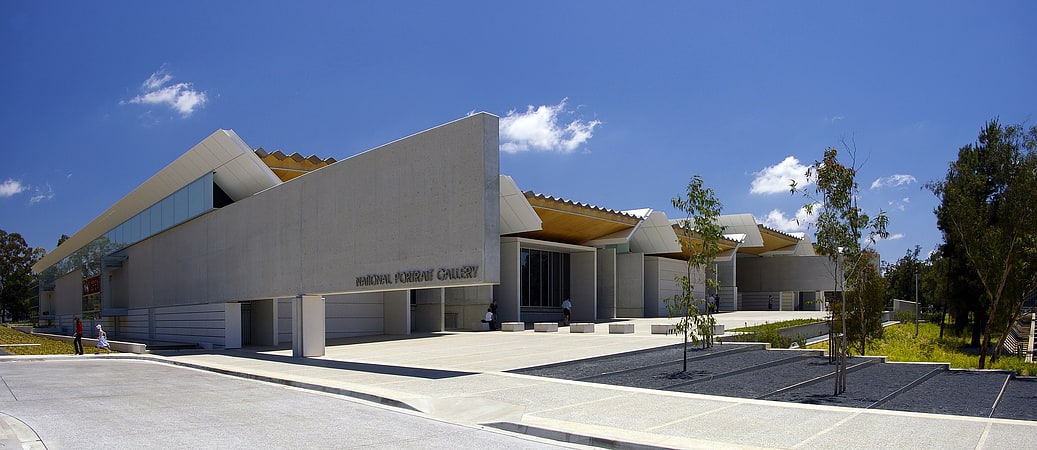
Modern gallery and portraiture collection. The National Portrait Gallery in Canberra is a collection of portraits of prominent Australians who are important in their field of endeavour or whose life sets them apart as an individual of long-term public interest. The collection was established in May 1998, and until 2008 was housed in Old Parliament House and in a nearby gallery on Commonwealth Place. On 4 December 2008, its purpose-built permanent home was opened on King Edward Terrace, Canberra – beside the High Court of Australia – by Prime Minister Kevin Rudd.[22]
Address: King Edward Terrace, 2600 Canberra (South Canberra)
National Film & Sound Archive
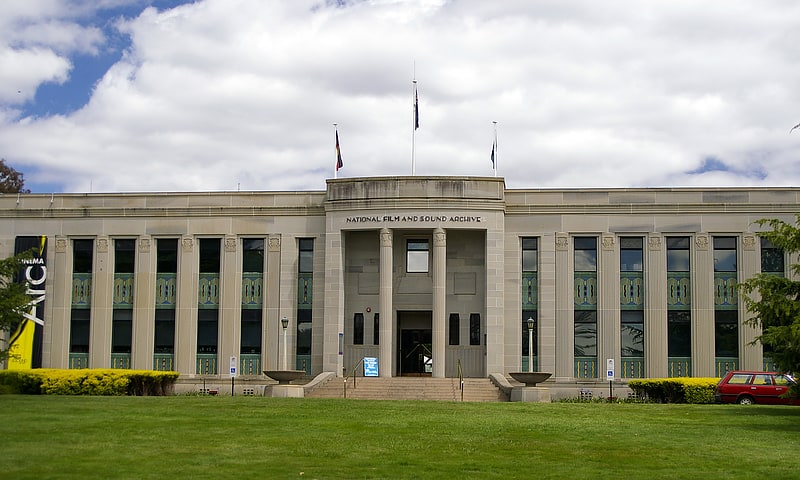
Archive in Australia. The National Film and Sound Archive of Australia, known as ScreenSound Australia from 1999 to 2004, is Australia's audiovisual archive, responsible for developing, preserving, maintaining, promoting and providing access to a national collection of film, television, sound, radio, video games, new media, and related documents and artefacts. The collection ranges from works created in the late nineteenth century when the recorded sound and film industries were in their infancy, to those made in the present day.
The NFSA collection first started as the National Historical Film and Speaking Record Library (within the then Commonwealth National Library) in 1935, becoming an independent cultural organisation in 1984. On 3 October, Prime Minister Bob Hawke officially opened the NFSA's headquarters in Canberra.[23]
Address: McCoy Circuit, 2601 Canberra (North Canberra)
King George V Memorial
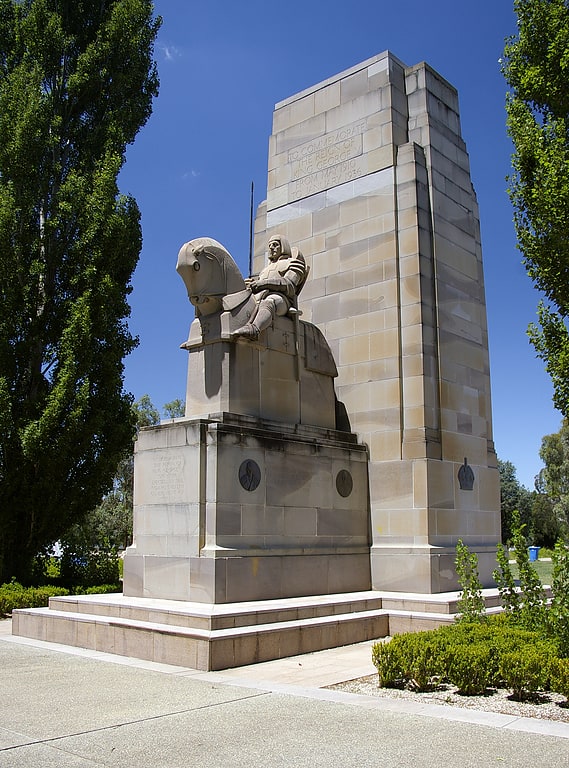
Historical landmark in Parkes, Australia. The King George V Memorial has been located outside Old Parliament House, Canberra since the 1940s. Commissioned in 1936 and largely completed by 1941, it took until 1953 to officially unveil the monument due to delays to the final elements of its construction which resulted from the Second World War. The Memorial was originally located directly in front of the-then Parliament House, but was moved to its current location in 1968.[24]
National Zoo & Aquarium
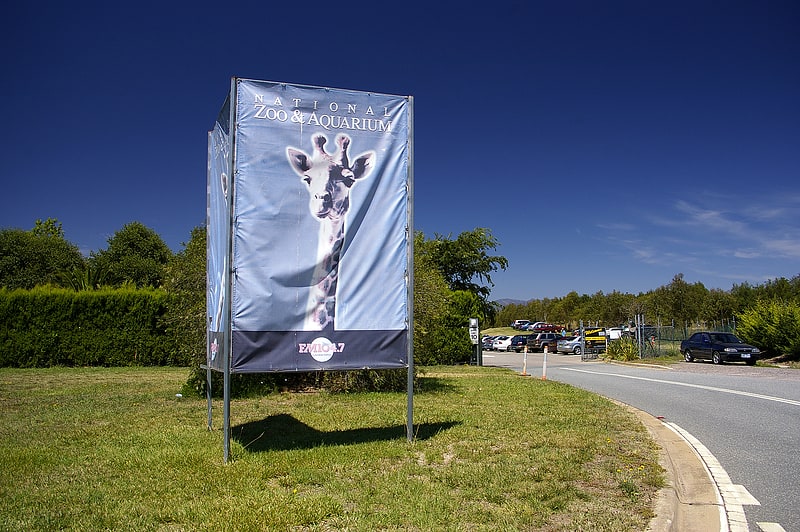
Interactive experiences with animals. The National Zoo and Aquarium is a privately owned 19-hectare zoo and aquarium in the Australian capital city of Canberra. It is located in Yarralumla at the western end of Lake Burley Griffin, next to Scrivener Dam. It recently had a major expansion, with 12 ha of open range exhibits opened in May 2017.[25]
Address: 999 Lady Denman Drive, 2611 Canberra
Canberra Stadium
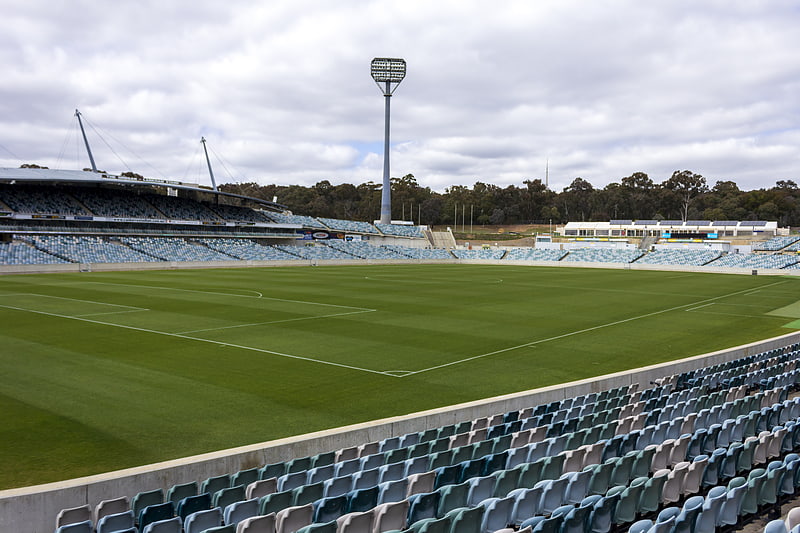
Sports facility in Bruce, Australia. Canberra Stadium is a facility primarily used for rugby league, soccer and rugby union games, located adjacent to the Australian Institute of Sport in Canberra, the capital of Australia. It is the largest sports venue by capacity in Canberra.[26]
Address: Battye St., 2617 Bruce (Belconnen)
Canberra Glassworks
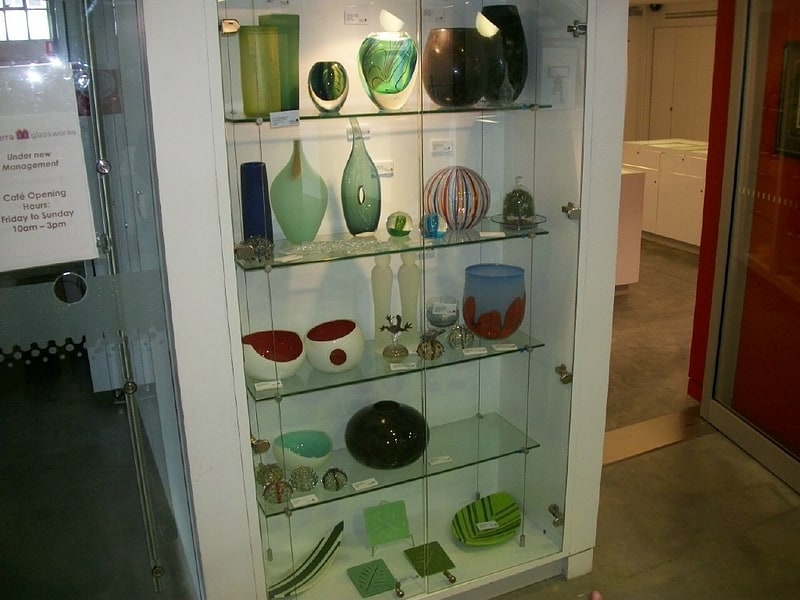
Art gallery in Kingston, Australia. Canberra Glassworks is an Australian gallery in Canberra and glass art studio open to the general public to view the glass artists working. Opened in May 2007 by Jon Stanhope, it is the largest dedicated glass studio facility in Australia.[27]
Address: 11 Wentworth Ave, 2604 Canberra (South Canberra)
Commonwealth Place

Event venue in Parkes, Australia. Commonwealth Place is located on the southern shore of Lake Burley Griffin, Canberra. It lies along the ‘water axis’ running along the lake from Black Mountain. Commonwealth Place is the location of the Gallery of Australian Design, Reconciliation Place, a restaurant and Speakers Square. Walter Burley Griffin, the architect who designed Canberra, envisaged that the area would be the site of a "water gate" which would have a terrace above it, providing a "forum for the people". Griffin's vision was for a long time left unrecognised but as of 2005 the area was being developed to reflect the original plan.
Speakers Square, at the centre of Commonwealth Place is a concave shaped grassed area with a paved mural in the middle which was a gift to Australia from the Government of Canada to mark the Centenary of Australian Federation. A display of international flags lines the lake shore, one flag for each nation with a diplomatic mission in the capital. Flags include those of the United Nations, European Union and the Holy See.[28]
Glebe Park

Park in Canberra, Australia. Glebe Park is a public park on the eastern side of Civic, Canberra, Australia. The park is bounded by Coranderrk, Ballumbir, Akuna, and Bunda Streets, and to the south, the National Convention Centre.[29]
Address: Coranderrk Street, Canberra (North Canberra)
Weston Park
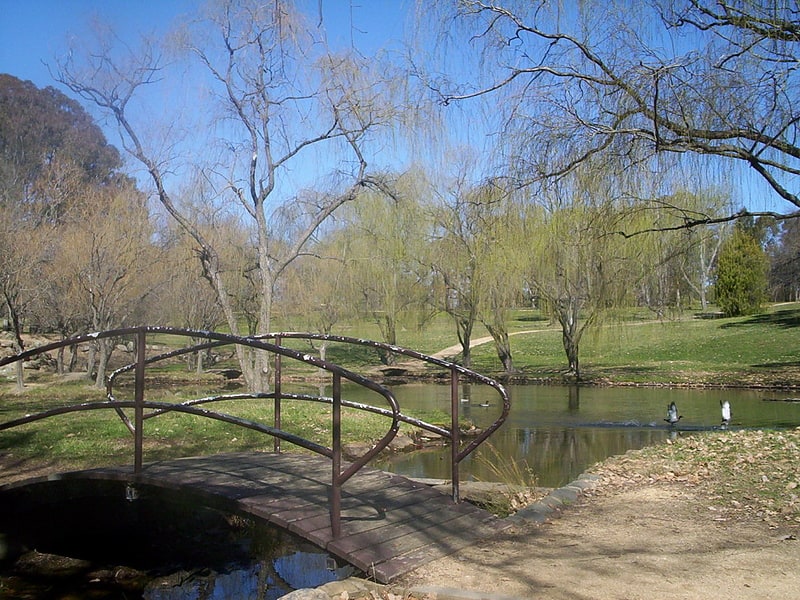
Park in Yarralumla, Australia. Weston Park is a park located on a peninsula on the western side of Lake Burley Griffin in Canberra, Australia. In 1963 the park was named after Charles Weston, who had founded the nearby Yarralumla Nursery in 1914. On the western side of the peninsula is Yarramundi Reach and on the eastern side is Tarcoola Reach. The end of the peninsula is called Kurrajong Point.
With water on three sides, children's playgrounds, picnic areas and barbecue facilities, Weston Park has a very pleasant atmosphere and is very popular on weekends and holidays. The park also has a miniature railway.[30]
Address: Weston Park Rd, 2600 Canberra (South Canberra)
National Emergency Services Memorial
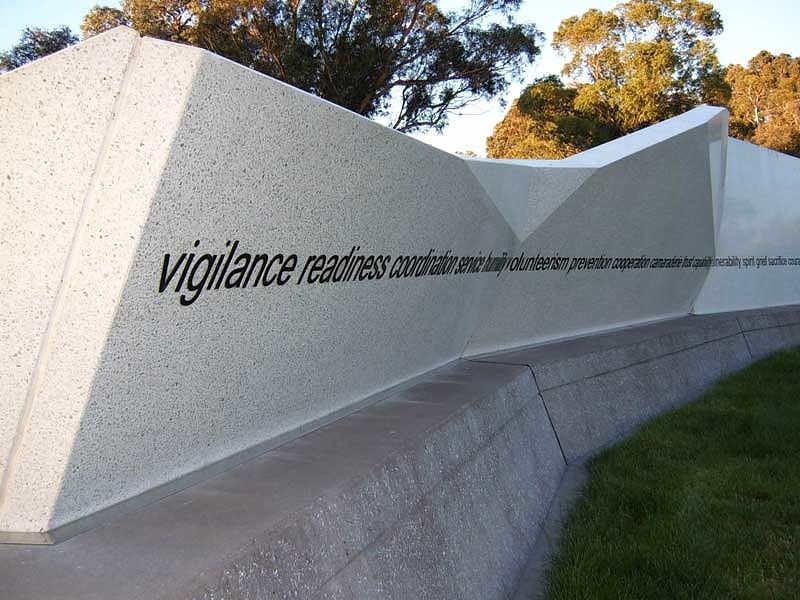
Memorial park in Parkes, Australia. The National Emergency Services Memorial is a memorial located on the northern shore of Lake Burley Griffin at the southern end of Anzac Parade in Canberra, the national capital of Australia. It was dedicated in July 2004.
The overall memorial was designed by Aspect Melbourne Pty Ltd. The frieze bas relief was created by artist Charles Anderson. The outdoor sculpture was created by artist Darryl Cowie.[31]
Mount Taylor
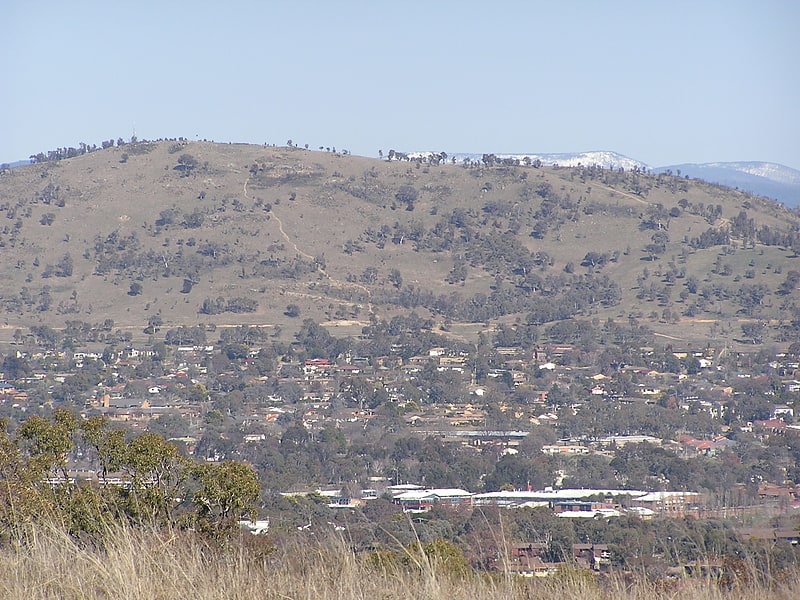
Peak in Australia. Mount Taylor is a prominent hill with an elevation of 856 metres AHD that is located between the Woden Valley, Weston Creek district and Tuggeranong Valley, in Canberra, within the Australian Capital Territory, Australia. Mount Taylor is part of the Canberra Nature Park and is surrounded by the suburbs of Kambah, Fisher, Waramanga, Chifley, Pearce, and Torrens. There are walking tracks to the peak. While there is no public road access to the peak there is a fire trail up the mountain from the end of Waldock St, Chifley where there is also a car park and picnic tables. The fire trail is normally closed to public vehicular access by locked gates, but the gates contain access points for walkers. The trail is especially popular with families and older walkers as it provides the easiest and most leisurely access to the peak. Originally a dirt road, it was partially sealed in 2009 on the steeper grades to make it safer for walkers and mountain bike riders.[32]
Address: Waldock St, Canberra (Woden)
Lennox Gardens
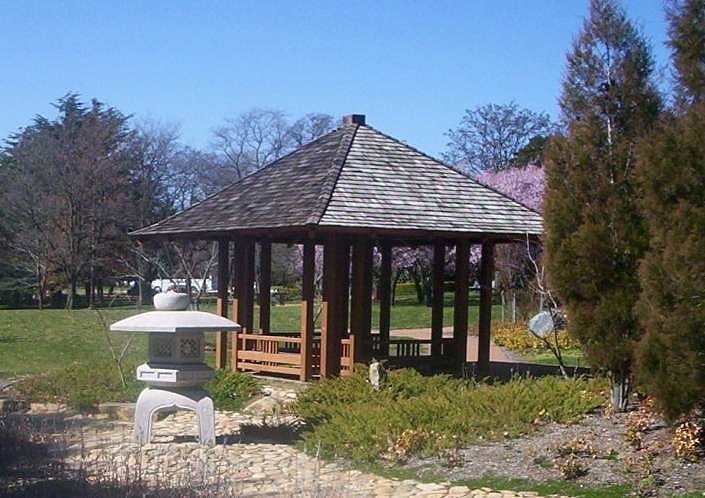
Garden in Yarralumla, Australia. Lennox Gardens, a park in Canberra, Australia, lying on the south side of Lake Burley Griffin, close to Commonwealth Avenue Bridge and Albert Hall in the suburb of Yarralumla. Before the construction of Lake Burley Griffin a road ran through the present garden, this road being one of two main crossing points across the Molonglo River. The name of the road was Lennox Crossing from which the present garden takes its name. The northern segment of the road is still present on Acton peninsula. The garden was officially named in 1963. Lennox Crossing was named after David Lennox, an early bridge builder in NSW and Victoria.
The park in its current condition was established with the filling of Lake Burley Griffin in the 1960s; however the park's history is much older, as it was part of the original Royal Canberra Golf course which is now underneath the lake. The part of the golf course which had not been flooded was named Lennox Gardens.
It has a number of memorials and monuments such as Kasuga stones presented to Canberra by Japan in April 1997, a monument to Australians in the Spanish civil war, and a stone monument commemorating the centenary of Federation and the Jewish National fund. It has a Wisteria pergola sponsored by Totalcare industries in celebration of the Nara sister city relationship.
Located within the park is the Canberra-Nara Peace Park (not to be confused with Canberra Peace Park), a park which symbolises the friendship between Canberra and the sister city of Nara, Japan.[33]
Address: Flynn Dr., 2600 Yarralumla (South Canberra)
Lake Ginninderra
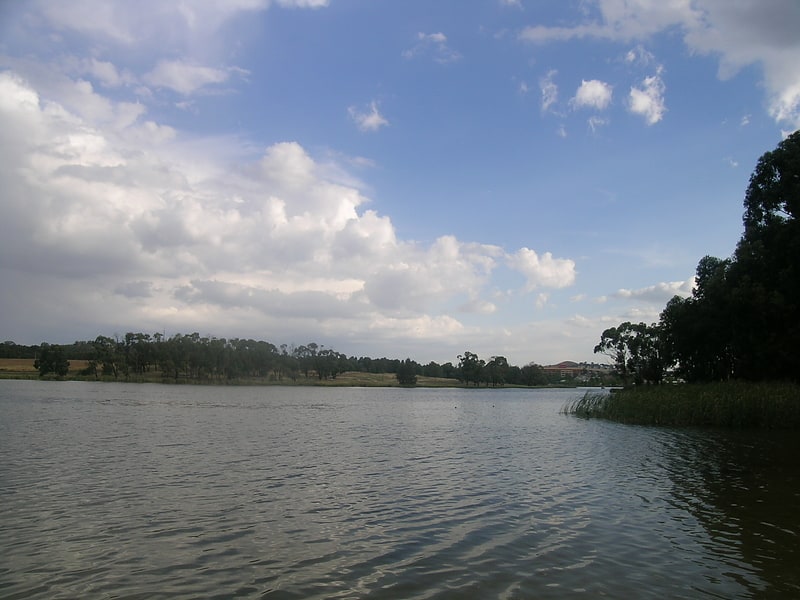
Lake in Australia. Lake Ginninderra is an artificial lake located on the Ginninderra Creek in Canberra. It is adjacent to the Belconnen Town Centre. The lake was constructed in 1974 to collect stormwater discharge from a 98.8 square kilometres catchment that includes the surrounding suburbs of Aranda, Macquarie, Cook, Bruce, Belconnen, McKellar, Giralang, Kaleen in the eastern areas of Belconnen.
The lake is home to much wildlife, such as the Black swan, moorhens, ducks and the Rakali.
The lake was formed through the construction of the Ginninderra Drive embankment across Ginninderra Creek. The lake has a surface area of 1.05 square kilometres (0.41 sq mi) and an average depth of 3.5 metres (11 ft). Water flow out of the lake is via a multi-celled concrete culvert structure and spillway chute on the Ginninderra Drive embankment.
During 2004 the Ginninderra Drive embankment was raised by one metre. The earthen embankments on the Coulter Drive side of the lake have been raised as well.
The Belconnen Arts Centre is located on its southern shore.[34]
Korean War Memorial
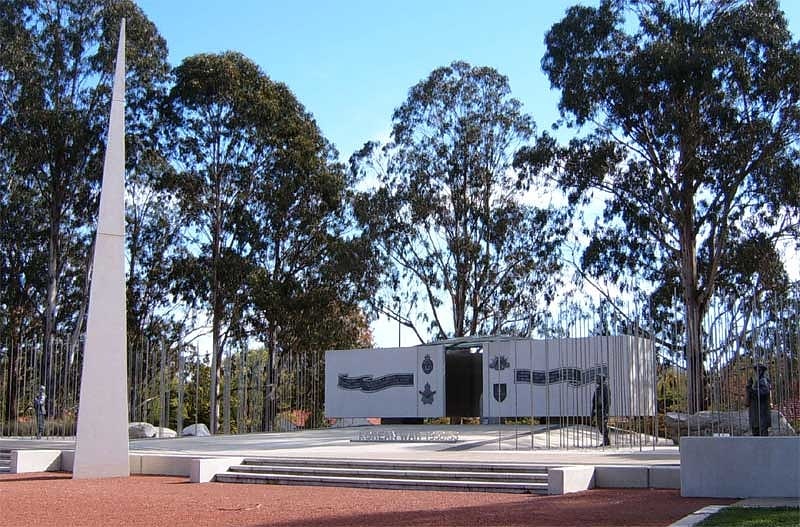
Monument in Canberra, Australia. The Australian National Korean War Memorial is on Anzac Parade, the principal ceremonial and memorial avenue in Canberra, the national capital city of Australia.
The Korean War began on 25 June 1950 when the forces of North Korea invaded South Korea. 17,000 Australians fought under the command of the United Nations until the armistice in 1953. This memorial commemorates and honours those who died and served.[35]